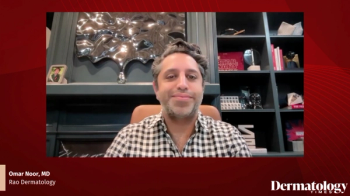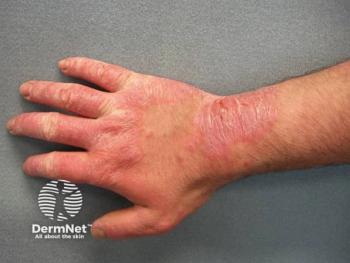
- Dermatology Times, Integrating Gene Expression Profiling Into Skin Cancer Care, September 2025 (Vol. 46. Supp. 05)
- Volume 46
- Issue 05
Gene Expression Profiling Guides Individualized Management in Melanoma and SCC
Key Takeaways
- Gene expression profiling (GEP) offers broader utility in personalizing melanoma and SCC care beyond traditional guideline-based algorithms.
- Case studies demonstrate GEP's role in assessing tumor biology and guiding treatment decisions, emphasizing its potential in risk stratification.
At a recent Dermatology Times Case-Based Roundtable event, Andrew Baker, PA-C, MBA, explored the management of skin cancers with GEP testing through 4 complex cases.
At a recent Dermatology Times
Although GEP is traditionally utilized to guide sentinel lymph node biopsy (SLNB) decisions in early-stage melanoma, the conversation highlighted a growing consensus that GEP offers broader utility in personalizing care beyond current guideline-based algorithms.
Case Studies
Case No. 1 involved a White man aged 54 years with a suspicious lesion on his left chest that had been changing over time. The patient had no history of skin cancer but frequently used tanning beds and vacationed in Florida. Upon biopsying, Breslow depth was 0.8mm. A 31-GEP test was ordered and returned with a Class 1A result. For treatment, a wide local incision was performed, and he has had no new or recurrent melanoma in 5 years.
Case No. 2 involved a White man aged 57 years with a lesion on his upper spine. He had no history of skin cancer and worked as a mail carrier. Upon biopsying, the Breslow depth was 0.6mm. The patient was referred for wide local excision and SLNB for his melanoma. No GEP test was ordered at the time. Overall, his SLNB results were negative, and there were no signs of residual melanoma. At the first follow-up visit, the patient had developed postoperative shoulder dysfunction that required 6 months of physical therapy. The patient had to retire early from his mail carrier job due to pain and impaired function. He still experiences pain and numbness 2 years after SLNB.
The featured case involved a patient with a thin melanoma who underwent SLNB based on traditional staging metrics. Despite the tumor’s biologic behavior being high-risk per GEP, the patient experienced a poor outcome, raising concerns that outdated protocols led to unnecessary surgical morbidity without clinical benefit. The patient’s trajectory led to functional debilitation and early retirement.
“What was important with this case is that it showed that the patient had a poor outcome," Baker said. "He lumped into historic staging and guidelines, and ultimately had an unnecessary procedure that left him debilitated and had to retire early from his job."
Case No. 3 involved a White man aged 93 years with a painful growth on his right ear. The patient lives with his family, is wheelchair-bound, and stated he wanted “nothing done” about his growth. After examination, he received a diagnosis of moderately differentiated SCC, and a 40-GEP test was ordered. The GEP test revealed a class 2A result. For a treatment plan, the patient was scheduled for stages of Mohs surgery.
Baker discussed data that show median disease progression rates demonstrated a 50% decrease in class 2B adjuvant radiation therapy-treated patient cohorts compared with class 2B untreated patient cohorts at 5 years after receiving a cutaneous SCC diagnosis.1
Case No. 4 included a White man aged 73 years presenting with a lesion on his right forearm measuring more than 2cm. He had a history of 1 wide local excision and 3 Mohs surgeries on his right forearm in 2021, and a rapidly growing tumor with perineural involvement in 2022. He was classified as a Brigham and Women’s Hospital staging as T2a, and a 40-GEP test was ordered. The GEP test revealed a class 2A result. The patient was referred to surgical oncology for SLNB of the right axilla; results were negative. Three months later, imaging found a mass on the patient’s neck, and a recurrent lesion was found on the right forearm. A biopsy of the neck and forearm showed SCC. The patient was started on cemiplimab. His scans are now clear, and he is doing well after 3 years of treatment.
“For most of the squamous cell cancer cases that are talked about, genetic expression profiling is used on the head or neck, but this is on the arm. So, there were a lot of varying opinions on how to manage that,” Baker concluded.
Practice Implications
Baker emphasized that the prevailing understanding of GEP’s clinical utility remains narrow. Many clinicians view GEP primarily as a tool to assess SLNB eligibility in early melanomas (eg, 0.3 – 1.0 mm of Breslow depth). However, the discussion presented the need to integrate tumor biology into broader risk stratification models regardless of tumor thickness or stage. GEP can provide actionable data for lower- and higher-stage melanomas, offering valuable input for decisions around surgical management, surveillance intensity, and even adjuvant therapy discussions.2
Importantly, the event conversation called attention to the ethical and clinical necessity of personalized decision-making, particularly in older patients or those with comorbidities. GEP may support nuanced, patient-centered care and facilitate shared decision-making between providers and patients’ families, especially when guideline-based care does not fully account for individual risk profiles or treatment tolerability.
Baker closed by noting that perspectives on GEP varied among attendees, especially regarding SCC of the extremities, where standardized use is less well established. This variability, he noted, makes case-based peer discussions so critical to advancing consensus and best practices in dermatologic oncology.
References
- Arron ST, Cañueto J, Siegel J, et al. Association of a 40-gene expression profile with risk of metastatic disease progression of cutaneous squamous cell carcinoma and specification of benefit of adjuvant radiation therapy. Int J Radiat Oncol Biol Phys. 2024; 120(3):760-771. doi: 10.1016/j.ijrobp.2024.05.022
- Guenther JM, Ward A, Martin BJ, et al. A prospective, multicenter analysis of recurrence-free survival after sentinel lymph node biopsy decisions influenced by the 31-GEP. Cancer Med. 2025;14(7):e70839. doi: 10.1002/cam4.70839
Articles in this issue
Newsletter
Like what you’re reading? Subscribe to Dermatology Times for weekly updates on therapies, innovations, and real-world practice tips.



















